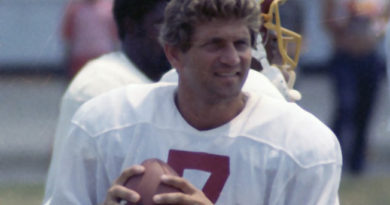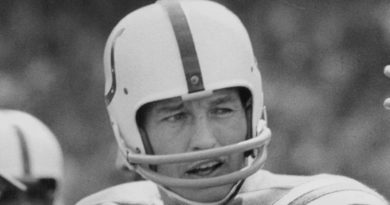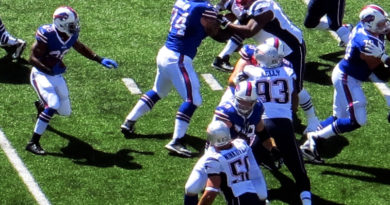The Emerging Importance of the Receiving Back in Today’s NFL
Woody Hayes, the legendary Ohio State football coach, once said, “Three things can happen when you pass the ball, and two of them are bad.” The prevailing theory in football used to be that a strong defense and good rushing attack were a team’s most important attributes if it aspired to be successful.
Fast forward to today and the sport is much different. Seven of the 12 playoff teams this season ranked in the bottom half of the league on defense. Conversely, 11 of the 14 highest-scoring teams in 2013 made the playoffs.
In recent years, rules have been altered to aid offenses in football. Wide receivers are now allowed to run their routes virtually untouched. Violent tackles are being removed from the game via penalties and suspensions. Quarterbacks’ heads can no longer be contacted by opposing players.
This has all made it easier for teams to throw the ball. Passing plays generally result in more yards than rushing plays and the clock stops on incomplete passes. More yards, less time off the clock, more possessions, more points. As a result of these changes, NFL scoring has soared in recent years. Teams averaged 23.4 points per game in 2013, up from 18.7 just 20 years ago. 11 teams averaged 25 or more points this past year; only one team did so in 1993. The Denver Broncos broke the all-time scoring record this past season, averaging nearly 38 points per game.
While the ground game’s role in football has remained relatively constant, teams have focused more and more on throwing the ball. This has resulted in more attempts and more yards through the air.
Game Averages Per Team
| Statistic | 2003 | 2013 | % Change |
| Rushing | |||
| Yards | 117.9 | 112.9 | -4.2% |
| Plays | 28.3 | 27.1 | -4.4% |
| Average Gain | 4.16 | 4.17 | +0.2% |
| Passing* | |||
| Yards | 200.4 | 235.6 | +17.5% |
| Plays | 34.3 | 38.0 | +10.5% |
| Average Gain | 5.84 | 6.21 | +6.4% |
* Passing number of plays and yards include sacks
Ball carriers have virtually become interchangeable and each franchise has adjusted its strategy for building a roster accordingly. How much has success in the NFL shifted away from the running game? Zero running backs were selected in the first round of the 2013 NFL Draft. Only one was taken in the first 30 picks in 2012. Twenty years ago, two of the top 10 and seven of the first 49 picks were running backs.
In 2013, four of the top eight rushing teams missed the playoffs – by a lot (those four teams combined to go 22-41-1). However, when looking at yards from scrimmage exclusively from the running back position, five of the top six and eight of the top 10 teams made the playoffs. More than ever, the top squads in the league are relying on their running backs in the passing game.
Since rushing the ball is no longer correlated to winning, it would stand to reason that the teams that pass the ball a lot must have done well. However, only seven teams that were ranked in the top half of the NFL (and on the other extreme, four of the bottom nine) in passing yards in 2013 qualified for the postseason. Furthermore, despite all the new rules that make it easier to throw the ball downfield, there were as many playoff teams (five) in the top 14 in the league in receiving yards by non-running backs as there were in the bottom 14.
Throwing the ball is not enough; passing the ball efficiently, however, is critical to a team’s success. The top seven teams in passing yards per attempt all made the playoffs. Of the 14 teams to average over seven yards per attempt, only Detroit (7-9) had a losing record. Kansas City was the only playoff team to place in the bottom 10 of the list.
The two simplest ways to increase a team’s passing yards per attempt are to complete a higher percentage of passes or to design plays that result in a receiver piling up a lot of yards after he catches the ball. Both of these can be accomplished via the screen pass. The New Orleans Saints attempted over 25% more passes to its backs than any other team in the NFL. Two running backs (Pierre Thomas and Darren Sproles) on New Orleans collectively ran for more yards after the catch (YAC) than everyone on the entire Tampa Bay offense combined. Predictably, Drew Brees, the Saints’ quarterback, was second in the league in completion percentage.
Ok, so teams should throw more screen passes to increase their offensive efficiency, right? Well, not exactly. In 2013, NFL teams attempted an average of 6.7 passes per game to running backs and fullbacks. Of the 12 teams to qualify for the playoffs, only half of them threw a higher than average number of screen passes. However, when a team’s passing offense is broken down into screen passes versus throws to wide receivers and tight ends, a trend becomes clear.
RB/FB Receiving Yards as a Percentage of Team Receiving Yards
| Team | Percentage |
| Miami Dolphins | 8.3% |
| New York Giants | 9.6% |
| Washington Redskins | 9.9% |
| Green Bay Packers | 10.1% |
| Minnesota | 10.7% |
| New York Jets | 11.6% |
| Houston Texans | 11.7% |
| St. Louis Rams | 11.9% |
| Dallas Cowboys | 12.0% |
| Tennessee Titans | 12.3% |
The teams on the list above made up the bottom 10 in the league in receiving yards out of the backfield as a percentage of total receiving yards (Kansas City led the league at 27.2%). Only one of these teams, the Green Bay Packers, made the playoffs.
Recall the high correlation between passing yards per attempt and teams that qualify for the postseason. As pointed out earlier, the top seven teams in that statistic made the playoffs in 2013 (as did five of the top six in 2012 and the top five in 2011). Nine of the 12 teams in the postseason were above the league average in passing yards per attempt. Having a pass-catching threat at running back greatly enhances a team’s passing efficiency. Of the teams listed above, some of their starting tailbacks missed significant time with injuries (Giants, Texans), while others just do not have a quality receiving option out of the backfield (Dolphins, Jets).
NFL teams used to draft big, bruising running backs to move the ball on the ground a few yards at a time. On third down, they would invariably insert a back who was about 5’8” (Dave Megget, Eric Metcalf, etc.) and would be better equipped to catch a pass. Today’s best running backs are able to both run the ball and catch a pass. The screen pass is not more prevalent today than it was 10 years ago. In fact, the total screen pass yardage for the league is down slightly from 2003. What has changed is the number of lead running backs who are capable of providing a dual threat, excelling in both rushing and receiving.
RBs with 500+ Receiving Yards in a Season
| Prior Six Seasons (2007-2012) | 2013 |
| Player | Seasons | Playoffs? | Player | Rec. Yds. | Playoffs? | |
| D. Sproles | 2010-12 | « | J. Charles | 693 | « | |
| R. Rice | 2009-11 | ««« | D. Woodhead | 605 | « | |
| A. Foster | 2010-11 | « | D. Sproles | 604 | « | |
| L. McCoy | 2010 | « | M. Forte | 594 | ||
| M. Forte | 2010 | « | K. Moreno | 548 | « | |
| D. McFadden | 2010 | J. Bell | 547 | |||
| C. Johnson | 2009 | L. McCoy | 539 | « | ||
| M. J.-Drew | 2008 | G. Bernard | 514 | « | ||
| B. Westbrook | 2007 | P. Thomas | 513 | « | ||
| R. Bush | 506 |
Note the explosion of superior pass-catching tailbacks this past season. 10 players were able to accumulate 500 or more receiving yards out of the backfield in 2013, only four fewer than in the previous six seasons combined. All 10 of the running backs with at least 500 receiving yards this year played on teams with offensive units ranked in the top 13 of the league. This was also true in 10 of the 14 instances from 2007-2012.
A generation ago, the screen pass often was considered a conservative play. Coaches did not want to risk an interception on third and long, so they would have their quarterbacks dump a pass off to the back and get whatever positive yardage they could muster. Today, on the other hand, the screen pass has become an aggressive weapon employed by many of the top teams in the NFL in any and all situations. It is ironic that with all of the rules changes that have led to an increase in vertical passing in today’s game, it is the safest, shortest throw in football that has become such a big difference maker.
And yet, through eight postseason games this year, the screen pass has been practically removed from each team’s playbook. Receiving yards by the backfield as a percentage of total receiving yards has declined for 10 of the 12 teams since the playoffs began. The four remaining teams would all rank below the worst regular season team.
| Team | Percentage |
| Seattle Seahawks | 2.9% |
| Denver Broncos | 5.2% |
| San Francisco 49ers | 7.3% |
| New England Patriots | 8.1% |
Even the regular season leader in this statistic, the Kansas City Chiefs at over 27%, had fewer than 9% of its receiving yards come from its running backs in their first round playoff loss. Not one of the seven 500+ yard receiving tailbacks who made the playoffs this year is still playing. New England is the only team left that is among the top six teams in playoff passing yards per attempt, that all-important statistic that leads to regular season success. In fact, the top three teams in the entire NFL in passing yards per attempt this year – Philadelphia, Seattle and Denver – now comprise the bottom three teams in that stat during the postseason.
The question is: Why change what got you here?
(photo by AJ Guel)



